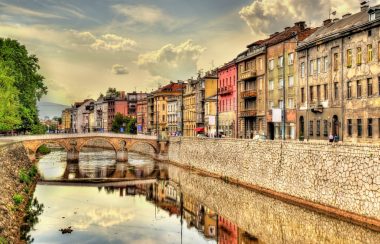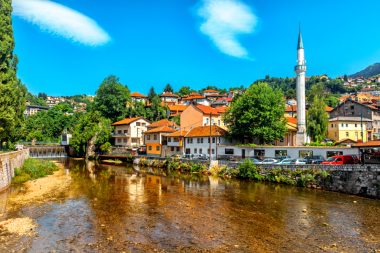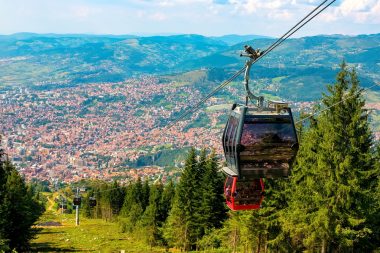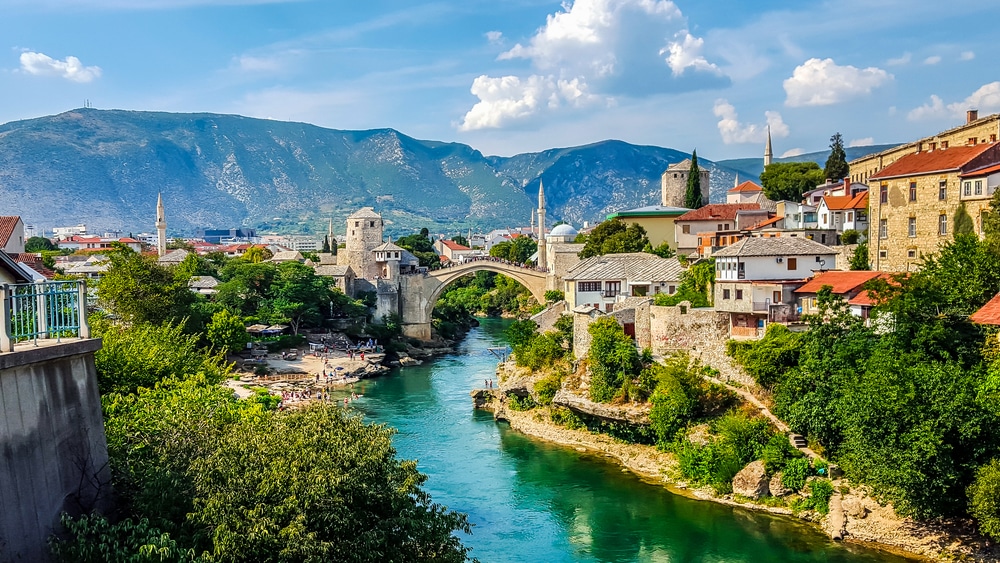A visit to the Bosnian city of Sarajevo is a moving journey back in time to past centuries. Buildings of different religions characterize the impressive cityscape of the 300,000-strong pearl of Bosnia.
The history of Sarajevo

As early as the 13th century, there is evidence of a Slavic settlement where Sarajevo is located today. But just two centuries later, what can still be called the curse and blessing of the capital of Bosnia-Herzegovina began: its location at the transition between Orient and Occident. A Bosnian who converted to Islam developed the city as an outpost of the Ottoman Empire, and at the end of the 15th century a Turkish governor built his Saray, his palace here – Sarajevo still bears this in its name today.
In the centuries that followed, West and East fought over the Balkans, as evidenced by numerous wars between the Western great powers led by the Habsburg Empire and the Ottoman Empire. But also a very enriching cultural exchange shaped the face of the Bosnian metropolis on the Red River, the Miljacka. Oriental builders created fascinating mosques and fountains, but Ottoman tolerance also made it possible for Christian and Jewish communities to live in the city.
Towards the end of the 19th century, the Ottoman Empire, the “Old Man on the Bosporus”, weakened, the Danube Monarchy occupied Bosnia-Herzegovina and made Sarajevo the capital of the province of the same name. The First World War began with the assassination of the Austrian heir to the throne Franz Ferdinand in Sarajevo. For us today, the Bosnian war from 1992 to 1995 is still vividly remembered. Serbian nationalists shelled the besieged capital of the newly proclaimed state of Bosnia-Herzegovina from the surrounding mountains. The wounds in the cityscape have healed after a quarter of a century and today Sarajevo once again presents itself as the pearl of Bosnia.
Melting pot of cultures: The sights of Sarajevo
Even though the population of downtown Sarajevo today consists mainly of Bosnian Muslims and only a few Serbs and Croats, the cityscape is characterized by numerous mosques, Catholic and Orthodox churches and synagogues. That is why Sarajevo, as a melting pot of cultures, is often called Little Jerusalem.
The Old Town

Sarajevo has an excellently preserved old town with the famous Baščaršija Square in its center. In the middle of it stands the oriental-looking Sebilj Fountain, built at the end of the 19th century, which is constantly surrounded by pigeons and provides a fascinating backdrop for the hustle and bustle of the market on the square. A stroll through the alleys of the old town is worthwhile! Here, well-preserved buildings can be used to recreate the life of Ottoman traders and dignitaries as well as that of Serbian merchant families. When crossing the famous Latin Bridge, which, despite its name, is an Ottoman stone arch bridge, you find yourself at the interface between Orient and Occident. This is even more true for the goat bridge east of the old town, which leads over the Miljacka in a tranquil angle. It belonged to an old trade route that connected Central Europe with ancient Constantinople.
The Islamic Buildings
One of the oldest mosques in Bosnia and Herzegovina is the Gazi Husrev Beg Mosque from the 16th century. The spatial experience inside is characterized by a monumental dome and the stone minbar from which the sermon is spoken. In the courtyard of the mosque there is a special gem: the lovely Šadrvan fountain. Opposite the mosque is the old Medresa, the Islamic college with an arcade-lined courtyard that invites you to linger.
Also worth a visit is the small Ali Pasha Mosque from 1561, which is characterized by finely engraved ornaments and graceful domes. The famous Imperial Mosque, which was also built in the 16th century and is located outside the city, does not conclude the series of fascinating oriental testimonies. This is where the Grand Mufti of Bosnia and Herzegovina has his seat today.
The Christian and Jewish buildings

The city’s old Orthodox church was built under Ottoman rule, and it is a testimony to the cultural and religious diversity in the city. The church dates back to the 16th century and is now a museum. The Cathedral of the Nativity of the Virgin Mary, which was built under the Ottomans as a concession to the Western powers, is used as a Serbian Orthodox place of worship. The magnificent neo-baroque building stands not far from the Catholic Sacred Heart Cathedral from the end of the 19th century, which was used by the Croatian population.
As a testimony to the former religious diversity, the Jewish cemetery is located on a slope outside the city. The oldest surviving graves date back to the 16th century. After the crimes of the Second World War by the Germans, there are only a few Jews left in Sarajevo, but they are trying to bridge the rifts between the different ethnic groups and religions.
The museums
A rich collection on the country’s multifaceted history is housed in the monumental National Museum, built in neoclassical style. In a separate secure room, you can admire a unique testimony to the Jewish faith, the illuminated manuscript of the Sarajevo Haggadah, which was written in Spain in the 14th century and brought to Sarajevo by emigrants.
Important prehistoric, natural history and ethnographic objects are part of the museum’s diverse collection. In the country’s Historical Museum, it is possible to obtain comprehensive information about the Bosnian War, to which the rebuilt National Library bears eloquent testimony. It is housed in the magnificent former city hall of Sarajevo, which went up in flames after targeted shelling in 1992 – along with its numerous bibliophile treasures. But like a phoenix from the ashes, the National Library has risen again – just like the pearl of Bosnia as a whole.
The landscape
Sarajevo is nestled in the valley of the Miljacka, surrounded by mountains and high-altitude resorts such as Pale. Today, despite all the tensions between the ethnic groups, it is peaceful in the city and its surroundings, a discovery of the pearl of Bosnia is more worthwhile than ever.



